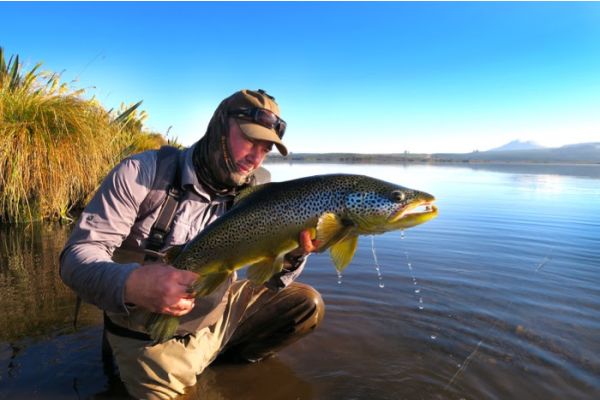UNDERSTANDING FLY LINE WEIGHT

From the rod to the fly and everywhere in between, there are several components to a fly fishing outfit ‒ and the weight of your fly line is one of them.
Fly line weight matters because it determines what you fish for and the success of your casts. However, fly lines come in various weights, and beginners don’t always understand the nuances of choosing the appropriate weight.
You can’t cast properly with the wrong weight fly line. Wild Water Fly Fishing is here to break down everything you need to know about fly line weight. Let’s get started!
FLY LINE WEIGHT AND ROD
Every fly rod is designed to work best with a specific weight fly line. Each rod blank will specify the weight line with which the rod performs best. Our most popular rod, the AX56-090-4, specifies a line weight of 5/6 on the blank. Because the line weight should match the rod’s specifications, you would want to use a 5 or 6-weight line on the AX56-090-4 rod.
WHY DOES THE FLY LINE WEIGHT DETERMINE THE FISH I CATCH?
Your fly line weight must also align with the size and type of the fly you use ‒ because, ultimately, your fly determines the fish you catch and the rod you use. In other words, your fly line weight and the type and size of your fly need to work in harmony to optimize your cast and help you catch the fish you’re targeting.
Let’s say you’re targeting large trout, which will require a large streamer. With the large streamer, a heavier fly line weight will give you more control of your cast. On the other hand, a lighter fly line would make it challenging to cast big heavy flies. The weight of a fly line carries the fly. The bigger the fly, the more weight you need to cast to the fish.
On the flip side, if you’re targeting smaller fish with a small delicate fly, a lighter fly line will enhance the cast and presentation and land on the water gently (as opposed to a heavier fly line, which would slam into the water and potentially scare fish away.) If you are fishing in clear shallow water, smaller line weights are best for less disturbance on the water’s surface.
WHAT IS THE BEST LINE WEIGHT FOR BEGINNERS?
At Wild Water Fly Fishing, we start new anglers out with a 5/6 fly fishing starter package that features a reel with a WF-5 fly line. This outfit is perfect for catching small trout, bass, or panfish.
If you’re only fishing in small streams, we recommend a 7’ rod with a 3/4 weight. This package features a reel with a WF-3 line.
FLY LINE WEIGHT: THE BASICS
Lines range from 00 to 12 weight. The bigger the number, the heavier the line. Lines between 3 and 10 weight are the most common.
A General Rule of Thumb: Use a light line when you want a delicate presentation. Light lines avoid disturbing the water’s surface and have a better chance of not spooking the fish.
Heavier fly lines have larger numbers, which are necessary for catching bigger and more powerful fish in larger bodies of water, including saltwater, with heavy or bulky flies and streamers. Heavy fly lines are best for longer casts and bigger flies.
Next, we’ll break down fly line weights and describe the type of fish you can target with each.
FLY LINE WEIGHT 00-4: PANFISH AND SMALL TROUT
Panfish and small trout are the primary fish you can target with fly line weights between 3 & 5. Typically, fishing with fly line weights of 3 to 5 is best in small, gentle streams. As you move into fly line weights of 5/6, you can start to target medium-sized trout in small to mid-range streams.
FLY LINE WEIGHT 5 AND 6: AVERAGE TROUT AND SMALL BASS
If you’re a beginner, starting with a 5 or 6-weight system is recommended. Making short casts with a light outfit can be challenging for beginners, so 5-weight is the sweet spot for catching small fish as you get accustomed to casting.
As you become more experienced, you can graduate to a fly line weight of 5 or 6. These are considered the everyman’s fly line weights and ideal for casting in faster-moving bodies of water.
You can catch virtually any size trout with a fly line weight of 5 or 6. If you’re targeting large trout, it’s recommended to go with a heavier 6-weight line. You can also target small and medium-sized bass.
FLY LINE WEIGHT 7 AND 8: LARGE BASS, SALMON, AND SALTWATER FISHING
Once you start moving into more powerful bodies of water, like the ocean, you’ll need a heavier fly line. A fly line weight of 7 or 8 will help you target large bass and large trout. Fly line weights of 8 or higher will help you target large salmon, big steelhead, and powerful saltwater fish.
HAVE QUESTIONS ABOUT FLY FISHING?
Gaining familiarity with fly line weight is a process and it doesn’t happen overnight. But don’t worry, as you get more practice and gain confidence in your casting skills, it’ll all start to make sense to you!
VISIT www.wildwaterflyfishing TO LEARN MORE TIPS AND TRICKS!
About Wild Water Fly Fishing
Wild Water Fly Fishing represents a dedication to bringing friends and family together by providing everything you’ll need to gear up for a trip to the lake. If you’re a parent or grandparent wanting to nurture a kid’s interest in fly fishing, Wild Water provides the best tools to make your fly fishing trip an unforgettable experience. Wild Water Fly Fishing is the only company to focus exclusively on affordable, easy-to-use fly fishing starter packages for all species of fish.
The post UNDERSTANDING FLY LINE WEIGHT appeared first on HuntingLife.com.
